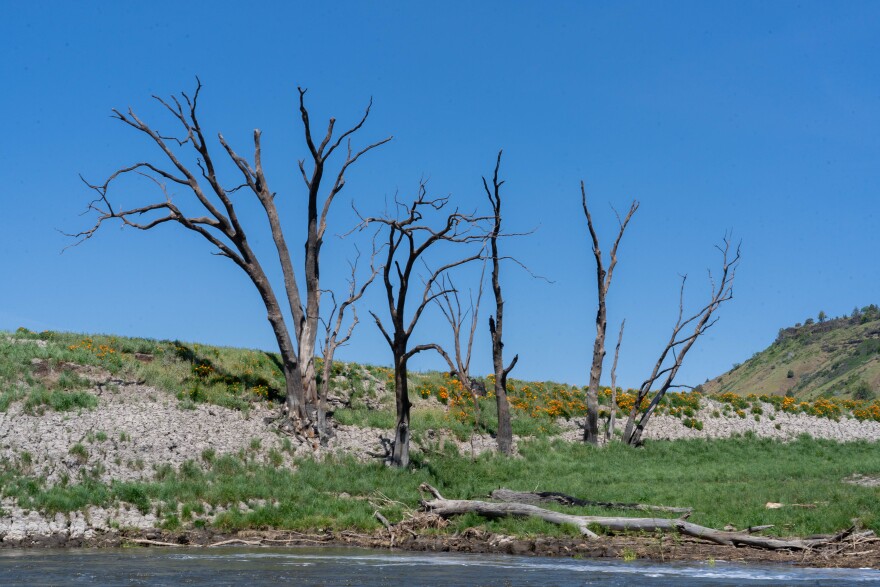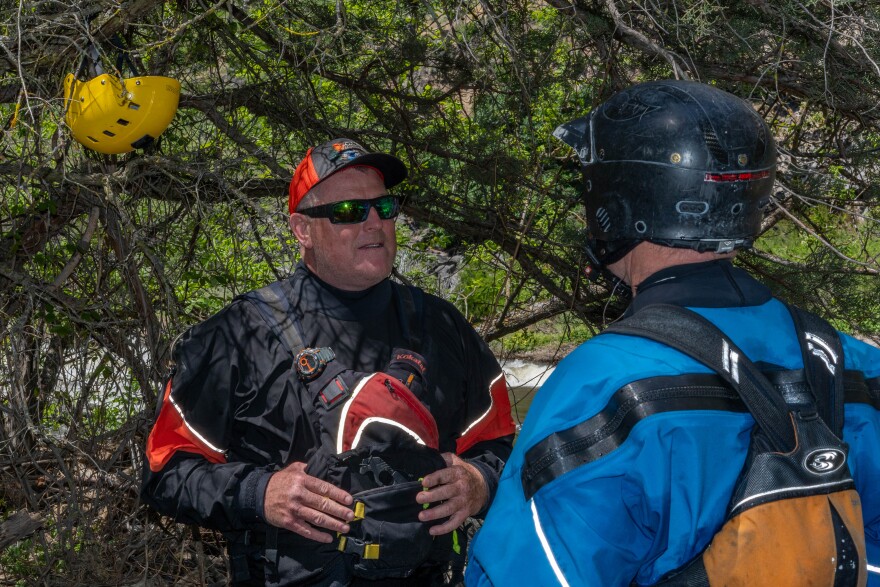On a warm spring day, a group of rafters made their way down the Klamath River near the California-Oregon border. The region has long been popular among whitewater fans, hosting a healthy number of rafting companies that offer daily floats during the warmer months.
But what makes this trip special is that, until recently, the section of river they were on didn’t exist.
“We’re in the Copco reservoir footprint,” said Bart Baldwin, owner of Noah River Adventures, as he paddled downstream. “We’d be underwater two years ago.”
Four dams had blocked the Klamath River’s natural flow for around 100 years, creating Copco Lake. The reservoir drained after the last dam was removed in October. Baldwin is guiding a raft on one of the first group rafting trips down the newly restored stretch of river.
“I’ve driven past this section, taking out from up above, hundreds of times,” Baldwin said. “The first time I saw it as a river, it definitely affected me a lot more than I thought it would.”

At first, the muddy basin left after the lake drained was an eyesore. Wildlife became trapped in the deep clay bed, and locals feared the sediment contained dangerous levels of heavy metals, like arsenic. Later testing found no risk to human health.
But things have begun to look better thanks to a massive replanting project, involving billions of seeds and a wet winter. Native grasses and flowers are beginning to carpet the valley. Bright orange California poppies are blooming along the shores of new beaches, and the river is finding its path, pushing sediment downstream.
A new river to explore
Baldwin said he’s run rafts down everything possible within 150 miles of Southern Oregon, and it’s exciting to have something new to explore.
“It's almost like somebody transported a new river for us to play on and get to know,” Baldwin said.
Baldwin and other guides are still mapping the river’s rapids, studying how they look with different water flows.
Before the dams came down, rafters timed their runs to catch regular pulses of water released from JC Boyle powerhouse. That's gone now. But in its place, new sections of river -- with new rapids -- have appeared.
For example, Kikacéki Canyon — formerly Ward's Canyon — was once bypassed entirely with water diverted for a power station. Few people saw its otherworldly geological formations. Now, the river flows through the canyon, beneath towering columns of volcanic basalt.

On this descent, the group pulls over for lunch at a small sliver of shore owned by the Bureau of Land Management.
“This might be the first time in over 100 years where folks have stopped and had a lunch along the banks of the river here,” said Will Volpert with Indigo Creek Outfitters.
Since this trip, many more have potentially stopped here. Dozens of Native American kayakers paddled the entire length of the river over the summer.
Public access vs. protection
The dams along the Klamath River came down after decades of advocacy to restore native salmon populations and return submerged tribal land. But Thomas O'Keefe with American Whitewater said recreation was always part of the discussion.
“How does the public interface with the restored river, and how do they experience it? That happens through recreation,” O'Keefe said.
Now the goal, he said, is to balance public access with protecting restoration and culturally sensitive tribal lands.
“I think it's just really important for the public to both visit this place with respect and dignity and also [be] safe,” O'Keefe said.
The rafters stopped at that small strip of public land for a reason: much of the surrounding area is restricted to protect restoration efforts.
The new land, currently owned by the Klamath River Renewal Corporation, will eventually be transferred to the Shasta Indian Nation. The 250-member tribe will decide what kind of access they want to allow along the riverbank.
The Shasta Indian Nation didn’t respond to multiple requests for comment.

As other dam removal projects are considered around the country, Baldwin thinks rafting is a powerful way for people to see results firsthand.
“The people can come every year… and see the difference in that picture that they took on that corner,” he said. “Watch it change every single year, as it grows in and fills in, and starts to regrow and heal itself.”
He’s looking forward to getting to know a free-flowing Klamath.
“Every river has got its own personality.”



